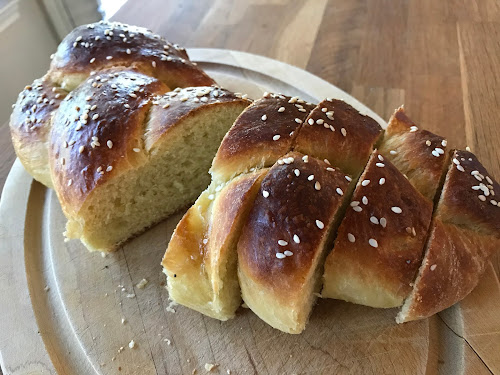I believe I haven’t talked about Jessica Fechtor’s Stir yet – it’s a memoir of her recovery from a brain aneurysm, and it’s by far one of the best books I’ve read this year. It’s also full of recipes, so it’s currently in my kitchen with a bunch of Post-It tabs sticking out of it! I’ve enjoyed her butter almond cake, but the recipe that’s really wowed me so far is her challah, which uses an interesting technique of folding instead of straight-up kneading the dough (it was created by her friend Andrew Jianjigian). It’s perfect on holidays like Rosh Hashanah, but there’s no need for a special occasion – she makes it almost every Friday.
This challah was fantastic! The dough was easy to braid, and I’m sure it could be shaped differently too. The loaves were beautifully golden (maybe a smidge too golden?) and the crumb was soft and delicious. I also loved this bread toasted and lightly buttered, though it should be said that it was still perfectly moist on day 2. The recipe makes two loaves; I sprinkled one with sesame seeds and one with poppy seeds, which are classics, but Jessica Fechtor also recommends rolled oats, flax seeds, pumpkin seeds or sunflower seeds. You could also use no seeds at all.
For the dry ingredients
4 cups (500 g) bread flour
11/2 tsp. instant dry yeast
2 tsp. fine sea salt
For the wet ingredients
2 large eggs plus 1 large egg yolk (save the extra white in a covered glass in the fridge for glazing later on)
3/4 cup (190 g) water
1/3 cup (75 g) olive oil
1/4 cup (85 g) honey
For sprinkling, before baking (optional): sesame seeds, poppy seeds, flaxseeds, rolled oats, sunflower seeds, and/or pumpkin seeds
Whisk together the dry ingredients in a large bowl, and the wet ingredients in a smaller bowl. Dump the wet ingredients into the dry ingredients and stir with a rubber spatula until a wet, sticky dough forms. Cover the bowl with plastic wrap and let sit for 10 minutes.
Peel back the plastic. Grab an edge of the dough, lift it up, and fold it over itself to the center. Turn the bowl a bit and repeat around the entire lump of dough, grabbing an edge and folding it into the center, eight turns, grabs, and folds in all. Then flip the dough so that the folds and seams are on the bottom. Cover tightly again with the plastic and let sit for 30 minutes.
Repeat the all-around folding, flipping, covering, and resting four more times. (She keeps track by drawing hash marks in permanent marker right on the plastic, but you could also set a timer on your phone for all rises, 5 in all.) The dough flops more than it folds in the first round or two. Then, as the gluten develops, you’ll get proper folds. By the final fold, the dough will be wonderfully elastic, and you’ll be able to see and feel the small pockets of air within. Pull the plastic tight again over the bowl and refrigerate for 16 to 24 hours—any longer and you risk over-proofing.
Cover a baking sheet with parchment paper and set aside. Transfer the dough to a lightly floured surface and divide into six equal pieces. Roll into six strands, each about a foot long and ¾ inch in diameter, dusting sparingly with flour when necessary to prevent sticking. (You’ll want to add as little extra flour as possible.) Form two three-strand braids, and transfer the loaves to the prepared pan. Cover with plastic and let proof at room temperature for 2 to 3 hours, until the dough is noticeably swollen and puffed and bounces back very slowly, if at all, when you poke it lightly with your finger.
Preheat the oven to 375 °F. Remove the plastic wrap from the loaves and brush with the reserved egg white. If you’d like, sprinkle with seeds. Poppy and sesame seeds are traditional challah toppings.
Bake for about 20 to 25 minutes, until the bread is golden and gorgeous and a tester inserted into the center comes out clean. You can also check for doneness with a thermometer; the internal temperature of the loaves will be 190 °F when fully baked.
Transfer to racks and let cool.






No comments:
Post a Comment